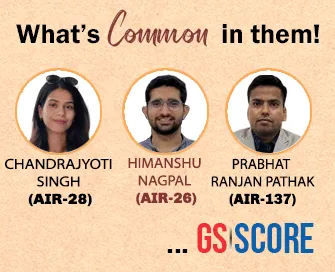

26th August 2023 (10 Topics)
Editorials
Context:
With the recent step of BRICS to include six more countries to its alliance, the organisation found a new purpose with its expansion, but also more contradictions.
The Recent Expansion
- BRICS Summit's 15th edition: It showcased global interest with 22 applications from 40 countries, emphasizing its growing relevance.
- Countries being included: BRICS expands ambitiously, adding Egypt, Iran, Saudi Arabia, UAE, Ethiopia, and Argentina, increasing membership from 5 to 11.
- Significance: Inclusion of major Middle Eastern and African-South American players underscores BRICS' evolving geopolitical and economic influence.
BRICS: Origin & growth
- Origin: BRICS emerges as counter-narrative to G-7, addressing issues from climate to sanctions, backed by practical initiatives like New Development Bank (NDB) and CRA.
- Importance of Organisation: With 30% global GDP each, BRICS gains parity with G-7; diverse representation spans 40% of world population.
- BRICS' expansion adds major oil suppliers, bolstering its energy influence and consolidating its significant global impact.
Contradictions around BRICS
- China’s global image: BRICS' success marred by internal discord, India-China rivalry, and potential conflicts arising from diverse inductions like Iran-Saudi Arabia.
- Russia’s war with Ukraine: Political caution needed to avoid discomfort among members with differing global power alignments; Russia's actions raised concerns.
- Way forward: BRICS' potential lies in shared prosperity and democratic global governance model, counteracting challenges for a cohesive and impactful future.


Editorials
Context:
Recently, the Poland has reported that Russia is transferring tactical nuclear weapons to Belarus, altering regional security and NATO dynamics. European strategic dialogues highlights geography's profound impact on nations' behaviour, shaped by location, resources, history, and culture.
Poland’s Geo-strategy
- Poland's history: The background of dominance, partition, and Cold War shaped its pursuit of EU and NATO membership for security and integration.
- Post-Cold War alignment with EU expansion: It matched US aim to bolster NATO's influence in Central Europe.
- Part of both NATO & EU: Poland joined NATO in 1999 and the EU in 2004, driven by historical experiences and geopolitical considerations.
Poland’s rivalry for Russia
- Poland's Strategic Diplomacy: Poland's historical experiences drove its push for EU and NATO expansion, particularly advocating for Ukraine.
- Emergence as NATO Force: Poland's strong support for US interests solidified its role in NATO, hosting troops and infrastructure.
- Military Build-up and Energy Diversification: Poland's rising defense spending, military acquisitions, and support for reducing EU dependence on Russian energy showcase its growing influence.
Growth and global stance
- Energy and Economic Dynamics: Poland's "Three Seas Initiative" bolsters energy diversification, aids economic growth, aligning with US interests.
- Economic Resilience: Amid Ukraine conflict aftermath, Poland's economy thrives, projected to outpace growth of major European economies.
- Geopolitical Impact: Poland's assertive stance faces EU concerns, reflects shift eastward in military, energy, and economic influence, shaping continental alignments.


Editorials
Context:
There is an estimation of increase in LegalTech's growth to 69.7 billion dollars by 2032, led by US and Europe, while Asia-Pacific (APAC) countries faces challenges and declining growth in terms of Technology inclusion.
LegalTech industry in India
- Challenge for Legal Industry and Technological Shift: LegalTech's growth in India faces resistance due to traditional methods, hindering innovation adoption.
- Dual Perception among Professionals: Survey reveals acknowledgment of LegalTech's significance but reluctance to embrace due to time constraints.
- Innovation vs. Billable Hours: Balancing learning new methods with chargeable work hours poses a barrier to LegalTech integration in practice.
Challenges of Technology
- Technical Constraints in LegalTech: Simon Chester (a pioneer in applying LegalTech in the practice of law) highlights legal complexity and data access issues as key hurdles to effective LegalTech implementation.
- Data Access and Privacy Concerns: Limited data access hampers machine learning's potential; cybersecurity threats demand a security-aware legal culture.
- Data Breach Challenges: Legal ecosystem grapples with uncertain breaches, hindering swift response; identifying breach sources requires resources and expertise.
Way forward
- Customization vs. Standardization: Lack of industry standard poses challenge for law firms to choose suitable LegalTech tools. There is a need for standardization.
- Strategic Selection over One-Size-Fits-All: Law firms should identify specific needs, avoiding complicated tools; industry tailored solutions needed.
- Overcoming Barriers for Progress: Despite obstacles, legal tech integration depends on innovation, awareness, and education fostering tech-friendly legal practices.


Editorials
This following brief delves into India's evolving fiscal federalism, necessitating reconsideration amidst shifting dynamics.
Evolution and Key Challenges
- Adaptability issue:The Indian Constitution, molded to manage centrifugal forces, has exhibited adaptability over time, encompassing economic shifts, multi-tier governance structures, and fiscal adjustments.
- Changed fiscal landscape:The transformation from a planned to market-driven economy, coupled with Constitutional Amendments and fiscal regulations, has reshaped the nation's fiscal landscape.
- Need for re-valuation:Amidst these changes, there arises a pressing need for a comprehensive reevaluation of India's fiscal federalism to align it with the evolving realities.
Key Focus Areas for Reform
- Equity in intergovernmental transfersis a central concern. Economic growth often disproportionately benefits the affluent, leading to rising income inequality.
- Introducing factorssuch as the Human Development Index (HDI) in tax distribution can help create a more equitable approach.
- Ensuring clarity:The evolving landscape, including a shift to a multi-party system and changing demographics, necessitates a fresh examination of the division of powers and responsibilities among various tiers of government.
Enhancing Fiscal Transparency and Balance
- Strengthening fiscal federalismalso entails bolstering local governance and addressing off-budget borrowing practices.
- Uniform system:Neglecting panchayat raj institutions and municipalities hampers the third tier's potential. A uniform financial reporting system for all tiers can enhance transparency, accountability, and efficiency.
- Reviewing off-budget borrowing:Additionally, reviewing off-budget borrowing practices by both Union and State governments is vital. Ensuring that all income and expenditure transactions fall under budgetary heads promotes transparency and financial discipline.



